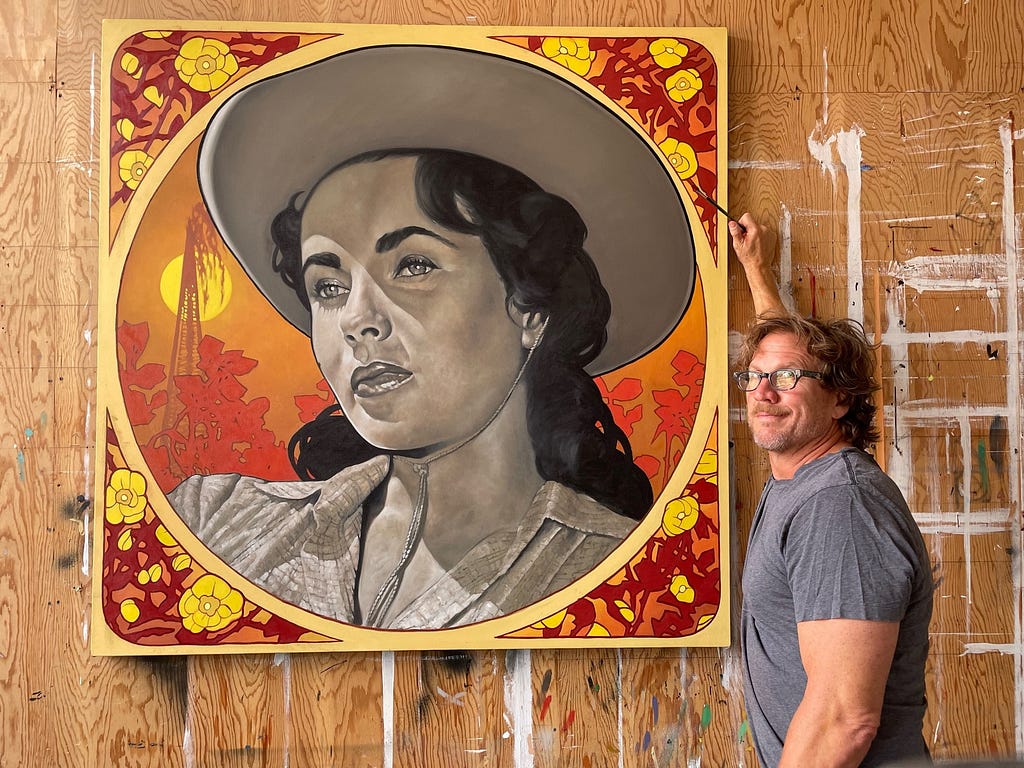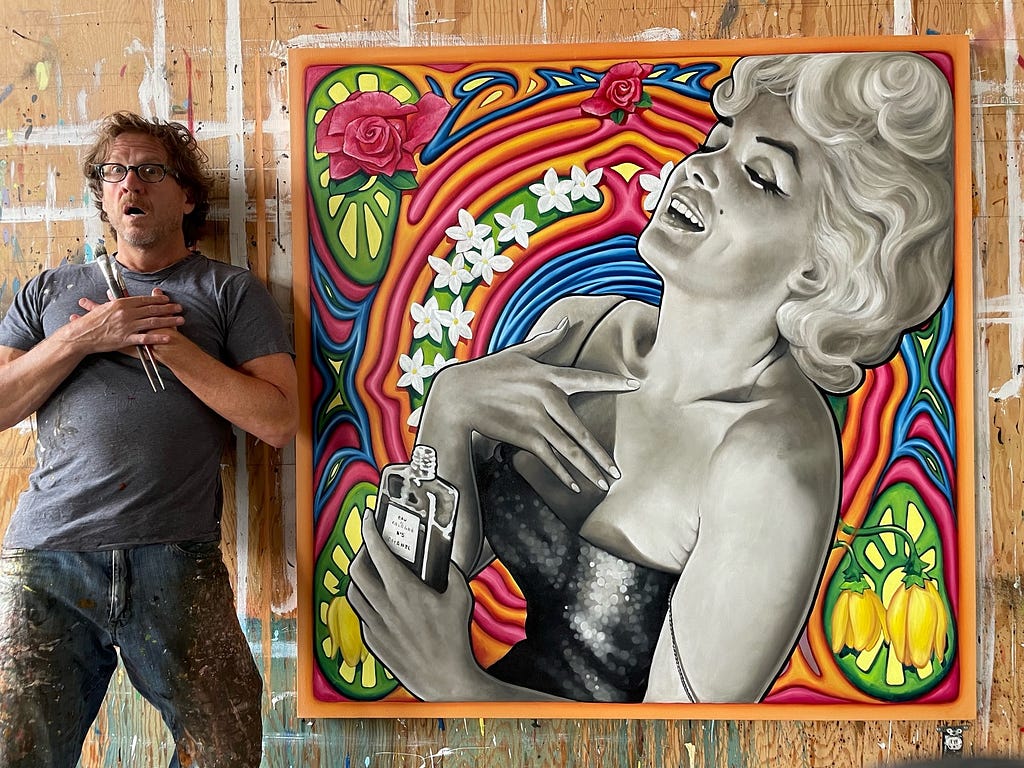
When I was younger, I confused difficulty with value. My undergraduate studies included art and bio. The bio came in handy for a few gigs early in my career, but I could have, should have, just stuck what I was good at. So, my №1 is pursue what’s easy. If it’s easy for you, you’re probably really good at it.
As a part of our series about “5 Things I Wish Someone Told Me When I First Became An Artist” I had the pleasure of interviewing William Nelson.
The intention of this work is to generate conversations about values and identity by assembling unlikely pairs, Hollywood film icons and nostalgic comic book environments. Each entity reveals a partial narrative. The nature of a comic and the personas of the movie stars, presented in the ethos of the Hollywood studio system, act as blank canvases for us to project our personal experience, principles and standards of behavior. There is a connection and a disconnect between these entities beyond technique. They exist within a single frame and are aware of each other’s existence yet there is an element of obliviousness. Something is happening and they can’t seem to take it in. Their dissociation, the separation of the two entities, compels comment.
Thank you so much for doing this with us! Can you tell us the story of how you grew up?
When I was a toddler, our family moved from Appleton, Wisconsin to Orlando, Florida when it was covered in orange groves years before the arrival of Disney. My mom stayed home with four kids and my dad taught art, humanities and was the head football coach at the Catholic high school. We were pretty free-range kids. Three of us are a year apart. When we were 4, 5 and 6, we would walk a few blocks to a secluded lake and swim to the other side where the cold springs bubbled up. Our mom would insist on us taking an empty one-gallon milk jug in case one of us got into trouble. The 1960s Florida life preserver solution stayed on shore.
Can you share a story with us about what brought you to this specific career path?
I had a lot of creative catching up to do early in my art career. I was confused about my meaning of passion. I equated passion to anger. I made large, dark, personal paintings that had limited appeal. I knew I did good work goofing around painting my young family, so I switched focus and started painting only what I loved. Suddenly work was fun. I should have taken the advice of one of my undergraduate foundation instructors. “You draw funny,” she said, then continued when she saw the look of disappointment on my face, “not funny, bad. Like funny. You’re funny!”
Can you tell us the most interesting story that happened to you since you began your career?
Two of the paintings I sold at my first show with Cavalier Galleries were shipped to Aspen, CO. I normally sign my work on the back. I forgot to sign one of the paintings and the buyers were none too pleased. The gallery owner, Ron Cavalier, told me to get my… self… on a plane and go sign that… painting. My brother lives in Aspen. He owns a very successful business that supports an Aspen lifestyle of skiing and fly fishing locally and South American surfing vacations. He dropped me off at the majestic home that now housed my paintings with a brush, jar of diluted ivory black oil paint and a drop cloth. The house was amazing- soaring glass curtail walls looking out on Aspen Mountain and pristine white walls and floors. The place was filled with art including a large fiberglass K.A.W.S. signed Warhol soup cans and a Warhol oil painting of his dog. Before I set to work, I was offered a drink. We drank tequila and, the owners being Texans, did not abide limes or salt or the like. I said I would enjoy a reparative beverage and… down the hatch! I set up my workspace like a priest preparing mass in a jungle mission. I pulled out the jar and shook its contents in preparation for the signing ritual. The cap flew off the jar and splashed oil paint all over the walls, floor and six Warhol prints. Just kidding, it went fine. My only mistake was after we left the premises, my brother and I went The Little Nell for more reparative beverages and I had an early flight.
What are some of the most interesting or exciting projects you are working on now?
I am presently inserting an original character into nostalgic New York cityscapes. The paintings whimsically address anxieties about how artificial intelligence increasingly affects our daily lives. Is an AI robot apocalypse inevitable? In Killer AI Robot NY1964 hostilities amount to our imagined mortal enemy dispassionately roller skating around the Unisphere at the 1964 World’s Fair. Perhaps there’s a 3-D element to this project in the future.
Who are some of the most interesting people you have interacted with? What was that like? Do you have any stories?
When you want to grow up to be an artist sometimes you gotta do what you gotta do. I hauled sheet rock up five floor walkups in Brooklyn and bartended with James Gandolfini before he was Tony Soprano. Jim poured drinks at my wedding, and we were kicked out of the Zig Zag Bar and Grill for smoking cigars the night my first son was born at St. Vincent’s. I was a PA for Richard Avedon when he was shooting weird Calvin Klein television spots. He was so smart it was exhausting. I worked very closely with another genius, Mort Subotnick on two projects. He was kind, patient, and a great hang. He introduced me to the bro hug before bros hugged.
Where do you draw inspiration from? Can you share a story about that?
My inspiration reaches back to my formative, art-starved years in central Florida. They are images from the Sunday Funnies in the Orlando Sentinel, where the words got in my way as an inordinately visual boy, and Saturday matinees at the Colony Theater, where nothing got in the way of the big screen. Many of these images are from a place where I began to gather my internal visual database, the sweaty south, two generations ago, where the closest thing to an art museum was Disney World, who assumed the mantle of local cultural epicenter from Gatorland, who ran help wanted ads in the Orlando Sentinel for Alligator Wrestler, No Experience Necessary. I still love Gatorland.
How have you used your success to bring goodness to the world?
I am guilty. Guilty I tell you, of sequestering myself in my studio away from the world. I’m not a great wordsmith but I think my work shares positive messages that may inspire. I also try to build a positive community for family and friends and help my fellow artists, and students that frequent my studio from time to time, be better artists.

What are your “5 things I wish someone told me when I first started” and why.
When I was younger, I confused difficulty with value. My undergraduate studies included art and bio. The bio came in handy for a few gigs early in my career, but I could have, should have, just stuck what I was good at. So, my №1 is pursue what’s easy. If it’s easy for you, you’re probably really good at it.
For most people no matter what the profession, it takes ten years to really be accomplished at anything. Gitty up!
I recently posed this question at a dinner party, a production assistant turned studio manager, turned agency photo producer, turned commercial film producer, turned photo editor, turned publishers director of photography, turned post-retirement Pilates instructor said, “Open yourself up to possibilities. Let things happen. Keep saying yes.”
A very successful package good entrepreneur wished she went to college. In her seventies, she still feels that a broader education would have served her personally and professionally.
A corporate super lawyer said, “You have two ears and one mouth for a reason.” That’s good advice, but I think he was actually responding to me interrupting him and busting his chops.
You are a person of great influence. If you could inspire a movement that would bring the most amount of good to the most amount of people, what would that be? You never know what your idea can trigger. 🙂
There is one sure way to end poverty. People need more money! My father worked hard. He was a teacher and that is an important job with huge responsibilities. He made precious little money. I paid for his funeral. Most people deserve better compensation. If I were in charge, every job would support two people. Perhaps we’d have less hungry kids and less angry adults.
We have been blessed that some of the biggest names in Business, VC funding, Sports, and Entertainment read this column. Is there a person in the world, or in the US whom you would love to have a private breakfast or lunch with, and why? He or she just might see this.
Hey, Jill Biden! Hello, if you’re out there. You seem to be one of my people. I’m a teacher’s kid. You have a good sense of humor. I do a great female portrait. When your job is done in Washington and you need a portrait, I got you.
What is the best way our readers can follow you on social media?
I am probably most current on Instagram, @nelson.william, but can also be found via my website (http://www.williamnelsonstudio.com/) and gallery representation, Cavalier Galleries (https://www.cavaliergalleries.com/artist/William_Nelson/works/).
This was very inspiring. Thank you so much for joining us!
William Nelson: 5 Things I Wish Someone Told Me When I First Became An Artist was originally published in Authority Magazine on Medium, where people are continuing the conversation by highlighting and responding to this story.
